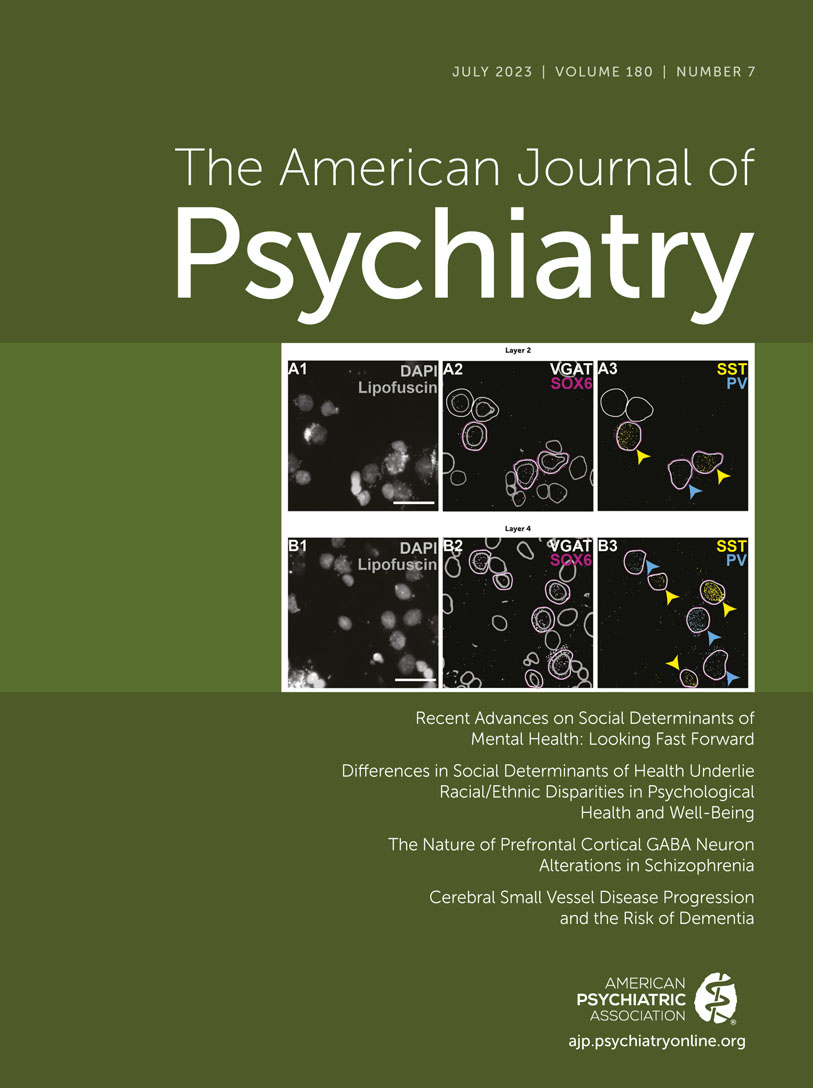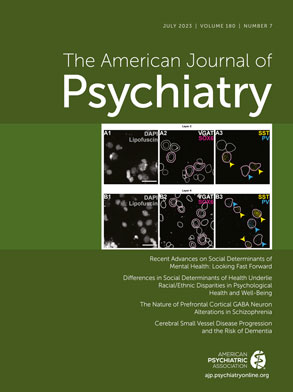Clinicians familiar with neuropsychiatric disorders in the elderly appreciate the subtle and sometimes not-so-subtle connections between these conditions and cerebrovascular disease, especially small vessel disease (SVD) occurring in subcortical areas. Geriatric syndromes related to SVD often feature alterations in mood, cognition, and movement. For example, research over the past 25 years has provided ample evidence for the existence of “vascular depression” (
1), consistent with the hypothesis that “cerebrovascular disease may predispose, precipitate, or perpetuate some geriatric depressive syndromes” (
2). Vascular dementia, conceptualized narrowly nearly 50 years ago as stemming from “small or large cerebral infarcts” (
3), has since been broadened to include not only multiple cortical and/or subcortical infarcts, but also strategic single infarcts, noninfarction white matter lesions, hemorrhages, and hypoperfusion as possible causes (
4). That is, current conceptualizations of vascular dementia include SVD etiologies. Finally, there is considerable evidence that cerebrovascular disease is linked to a variety of movement disorders, with “vascular parkinsonism” being well recognized by colleagues in neurology (
5).
Yet, from a clinical standpoint, especially for geriatricians, the separation of mood, cognitive, and movement consequences of SVD is somewhat artificial. Late-age-onset depression is related to slowed cognition and lack of spontaneous movement (psychomotor retardation) (
6). Vascular cognitive impairment, including dementia, is associated with disturbances of mood and gait (
7). Individuals with vascular parkinsonism (and classical Parkinson’s disease, for that matter) are at risk for depression and exhibit executive impairment (
5).
A multifaceted perspective on the clinical consequences of SVD also leads one to think broadly about the underlying etiologies and contributing factors to changes in mood, cognition, and movement. For example, viewing development of SVD as a consequence of proinflammatory factors and vascular risk conditions may be instructive clinically. Proinflammatory states brought about by dietary factors might become targets for prevention and treatment (
8). Better management of hypertension, diabetes, hypercholesterolemia, and other conditions that increase risk for vascular brain changes then becomes part of the overall management of late-life depression, cognitive impairment, and movement disorders.
For clinicians, equally important as a broader conceptualization of manifestations of cerebrovascular disease, especially SVD, is a longitudinal perspective on the effects of vascular change on various geriatric outcomes. Given proinflammatory and vascular conditions related to both SVD and neuropsychiatric disorders, it makes sense to posit that increasing burden of SVD would be related to worsening cognition and eventually to the development of dementia. An investigation seeking to test this hypothesis requires a large sample of non-demented older adults willing to undergo repeated clinical, neuropsychological, and neuroimaging assessments over a number of years sufficient for individuals to develop new-onset of dementia. Characterization of dementia by experts in cognitive assessment using well-recognized diagnostic criteria is also key to ensuring accuracy, classification, and timing of dementia diagnoses. This issue of the Journal features one international study that meets these requirements.
In their investigation of SVD and dementia risk, Jacob et al
. (
9) examined data on 503 non-demented community-dwelling participants in the Radboud University Nijmegen Diffusion Tensor and Magnetic Resonance Cohort (RUN DMC), a longitudinal study of subcortical vascular disease. The RUN DMC study included clinical, neuropsychological, and neuroimaging data at baseline in 2006 and in subsequent waves in 2011 and 2015, and a later wave in 2020 that did not include neuroimaging. Vascular risk factors were identified using blood pressure measures (with hypertension defined as systolic blood pressure ≥140 mmHg and/or diastolic blood pressure ≥90 mmHg), reports of use of glucose-lowering drugs (to define diabetes) and lipid-lowering drugs (to define hypercholesterolemia), and reports of ever versus never smoking. New diagnoses of dementia were assigned by a consensus panel of experts, who also diagnosed Alzheimer’s disease and vascular dementia using standard criteria.
Important for this discussion, the MRI images were acquired on 1.5-T scanners with a standard structural protocol for obtaining brain volumes of key regions and assessments of vascular disease burden and integrity of white matter tracts. Fluid-attenuated inversion recovery (FLAIR) sequences were used to identify white matter lesions representing vascular disease. In terms of deriving variables of interest, volumes of key structures were obtained via an automated method, while markers of SVD were derived using a semiautomated method requiring input from trained technicians and raters blinded to clinical data to characterize extent of lacunar infarction and cerebral microbleeds, two key features of cerebrovascular disease. Finally, a scanning sequence known as diffusion tensor imaging (DTI) was used to assess integrity of white matter tracts. Investigators then used an advanced method known as peak width of skeletonized mean diffusivity, an automated quantitative DTI marker for assessing white matter injury and predicting cognitive outcomes of neurologic disorders (
10).
The authors found that SVD severity at baseline as well as SVD progression over a 9-year course each increased the risk of incident all-cause dementia over a follow-up of 14 years. Their statistical models included key covariates, such as age, sex, education level, vascular risk factor score, baseline imaging measures of SVD, and hippocampal volume.
The take-home finding from this study is fairly accessible to clinicians: Worsening vascular change in the brain is associated with development of dementia over time. This study focused on incident dementia related to SVD stemming from occlusion of small arteries occurring in subcortical areas, as opposed to cortical vascular disease and larger arterial infarcts. The consequences of this conclusion also have readily identifiable clinical implications. Improved management of conditions known to cause and likely worsen SVD may help prevent development or worsening of dementia. Better control of hypertension, diabetes, and hypercholesterolemia, as well as smoking cessation, may each play in role in dementia care and prevention. For older cognitively impaired adults with multiple providers, collaboration between dementia specialists and primary care or medical specialty providers managing vascular risk conditions thus becomes essential to optimize patient outcomes and “bend the curve” of cognitive decline. Of note, this is the case not just for patients with vascular dementia. There is a growing literature linking vascular disease to Alzheimer’s disease (
11), including hypertension as a recognized risk factor for incident Alzheimer’s disease (
12); hence, efforts to diminish vascular risk can also improve outcomes for these patients. Another consequence of worsening SVD is seen in geriatric depression, where greater longitudinal increases in white matter hyperintensity volume are associated with more persistent depressive symptoms (
13).
A focus on reducing proinflammatory factors may also prove to be an important route to dementia prevention and treatment. As noted above, dietary factors may be associated with higher proinflammatory states, and there are studies linking diet to dementia risk. For example, healthy dietary patterns (e.g., those consistent with the Mediterranean diet, which is rich in fruits, vegetables, whole grains, and heart-healthy fats) were associated with slower cognitive decline and reduced risk of developing dementia, while patients with unhealthy dietary patterns (e.g., those consistent with a traditional Western diet) had worse cognitive outcomes (
14).
A final comment on the clinical impact of the Jacob et al. study relates to the imaging itself. Psychiatrists and other clinicians caring for older adults at risk for or suffering from dementia will benefit from keeping up with advances in neuroimaging technology and imaging processing that will better characterize brain changes associated with vascular disease. This is not as tall an order as it seems. As automated (i.e., computerized) approaches move from the research arena to clinical practice, it will become routine to encounter radiology reports of volumes of key structures (e.g., the hippocampus), extent of cortical and subcortical vascular brain damage (e.g., volume of white matter hyperintensities and integrity of key white matter tracts), and perfusion deficits in vulnerable brain regions. Adopting a new language based on emerging neuroradiological approaches will help the clinician understand the extent of underlying damage and better convey a prognosis and treatment plan to patients and families. Here, it is important to understand what DTI is and how its measure of white matter tract integrity informs clinical care. Whether the more advanced method of “peak width of skeletonized mean diffusivity” will become part of our clinical lexicon remains to be seen.
In sum, the study by Jacob and colleagues, while focusing on small vessel changes and dementia risk, also serves to remind us about the profound and broad impact that cerebrovascular disease, especially SVD, has on cognition, mood, and movement in older adults. Clinicians need to be mindful of vascular risk and underlying etiologies such as proinflammatory states in order to collaboratively care for patients and families. Moreover, familiarity with advances in neuroimaging will aid clinical management, informing prognosis, prevention, and treatment for this complex group of older adults.

